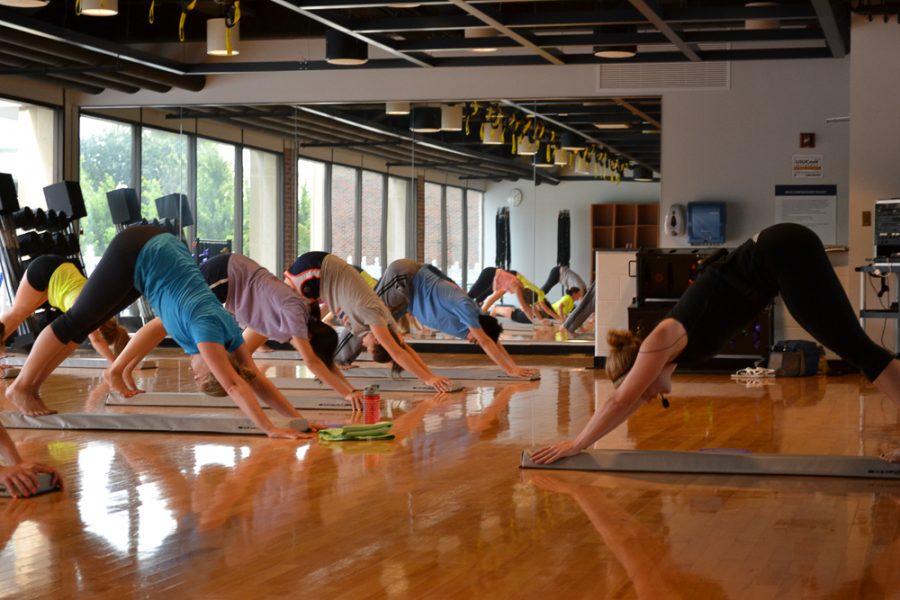Student Personal Trainers help clients achieve goals
The BeamWork class, led by instructor Sara, works on strength of mind and body.
Nov 30, 2016
A typical session with a certified personal trainer equipment starts with a light cardio warm-up on a stationary bike or treadmill. After the warm-up is some kind of resistance training using equipment such as exercise balls or hand weights. The next portion is the main workout, which is usually cardio and involves circuit training. The workout ends with some more resistance training and a slow cool-down on either a treadmill or rowing machine.
During the session, the trainers work closely with their clients. They give tips on how to be more successful in the workout, correct form and motivate each client to push himself further.
The trainer’s role is to help clients achieve their goals, which varies from losing weight to gaining strength. Trainers do this by evaluating the client and then creating exercise plans.
Personal training at the University is available through Campus Recreation, and trainers are all students. The majority of personal trainers are studying kinesiology or some field related to health. Each trainer has received his or her certification through either the National Academy of Sports Medicine or the National Strength and Conditioning Association.
However, students who aren’t studying kinesiology can become personal trainers as well; anyone who meets the criteria is eligible. The field is not limited to those solely with exercise science backgrounds.
Get The Daily Illini in your inbox!
Erin O’Donnell is an NASM-corrective exercise specialist and a personal trainer at Campus Recreation.
O’Donnell said she decided to become a personal trainer because she knew that she wanted to go into a field related to kinesiology after graduating. She said this seemed like one of the best ways to get to work with people and apply exercise science knowledge as well.
According to the NASM and NSCA handbooks, to become a Certified Personal Trainer, a potential trainee must have a high school diploma, be CPR and AED certified and be 18 years of age. Every trainer must also pass a test distributed by either NASM or NSCA.
Both organizations offer different packages to help personal training students prepare for the exam. NASM offers four options with prices ranging from $699 to $1,999. NSCA has two packages from $210 to $480. NSCA also offers additional resources for purchase. All selections are for sale online on the NASM and NSCA websites. Registration for the certification test holds an additional cost.
Students have six months to study for the exam; however, the material only takes about three to four months to cover. After passing the test, the certification is valid for two years.
The information students learn teaches them how to help clients achieve results.
“If you have someone who’s never trained before you have to learn what to do with them first to make sure they’re ready to go into harder workouts,” O’Donnell said. “Something like stabilization just getting them to, correcting any imbalances, things like that. It also focused heavily on any movement disorders or patterns. So if someone has one muscle tight, how will this affect it, how will you fix it?”
Christopher Collins-Terry, an NSCA certified personal trainer, said there is a counseling aspect that comes along with being a trainer.
“It was something that I wasn’t really expecting when I got this job,” Collins-Terry said.
The Activities and Recreation Center has a personal training studio where only clients and trainers are allowed to work out. In the studio, there are exercise machines, weights and other accessories.
Campus Recreation has a number of different options for training sessions. There are individual and group sessions lasting either 30 minutes or one hour. Prices range from $15 to $30 depending on the package.
O’Donnell said many people who utilize personal training are not only students, instead there is a mix of students, professors and C-U residents.
There is such a large number of requests for personal training through Campus Recreation that they are no longer accepting them.
Collins-Terry said the worst part about being a trainer is the scheduling. Many times, it’s difficult to schedule clients back to back and sometimes there are large gaps of time in between each client.
“The more clients you get, the more erratic your schedule is going to get because each client has their individual schedule you need to work around,” Collins-Terry said.
O’Donnell said she believes clients and trainers benefit from sessions. Clients work toward their goals and hopefully achieve them. Trainers gain experience that can help them in the classroom, and in their future careers.
“I think you can learn things in class and they make sense but you don’t really understand why they matter maybe, or you don’t understand how it’s applicable until you actually go use that information,” O’Donnell said.
She said sometimes she writes a perfect workout schedule and then ends up changing it completely because a client’s needs change with every session.
“You just learn on the job a lot. It’s really cool, I would recommend it definitely for kinesiology majors,” O’Donnell said.






